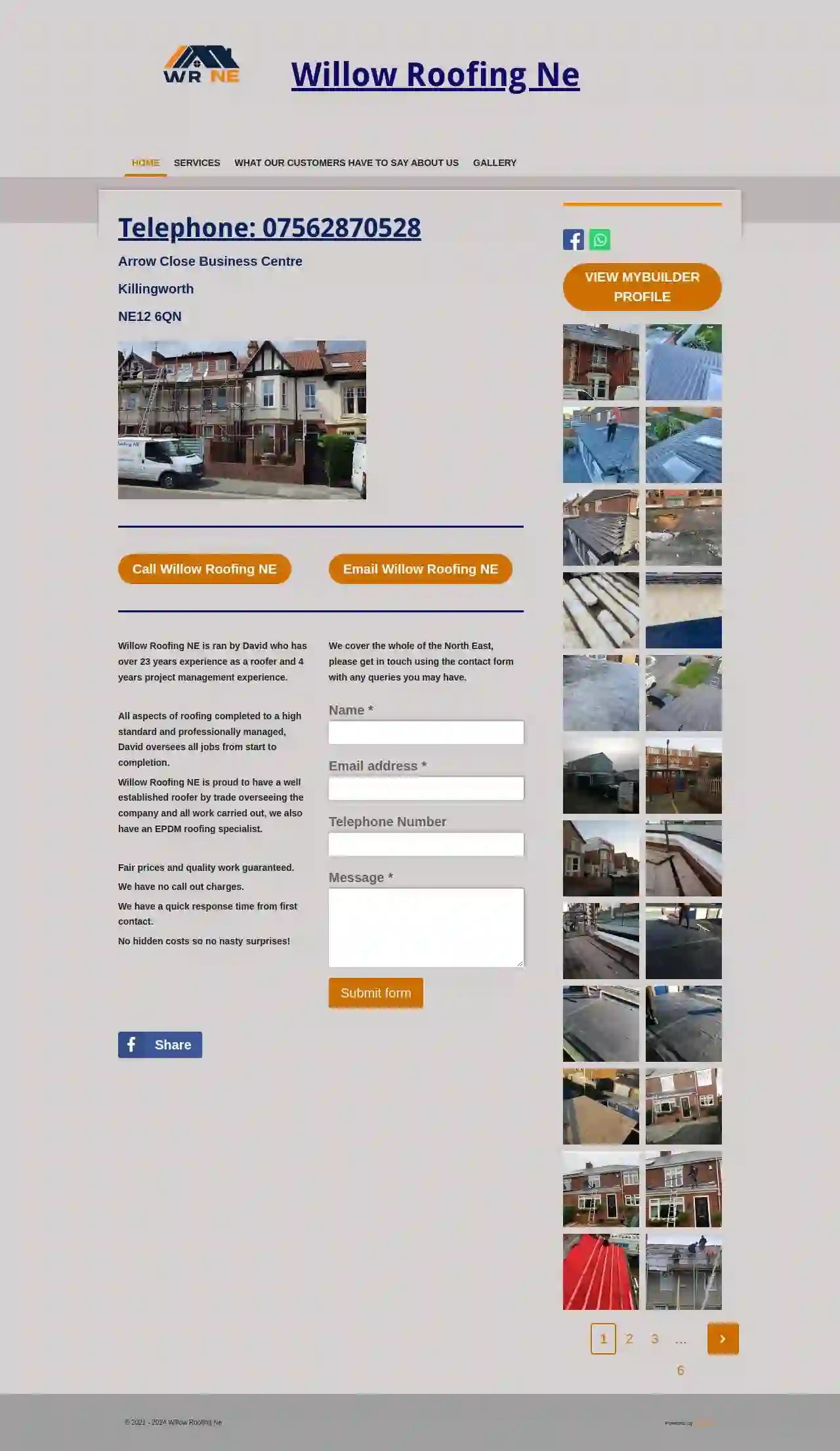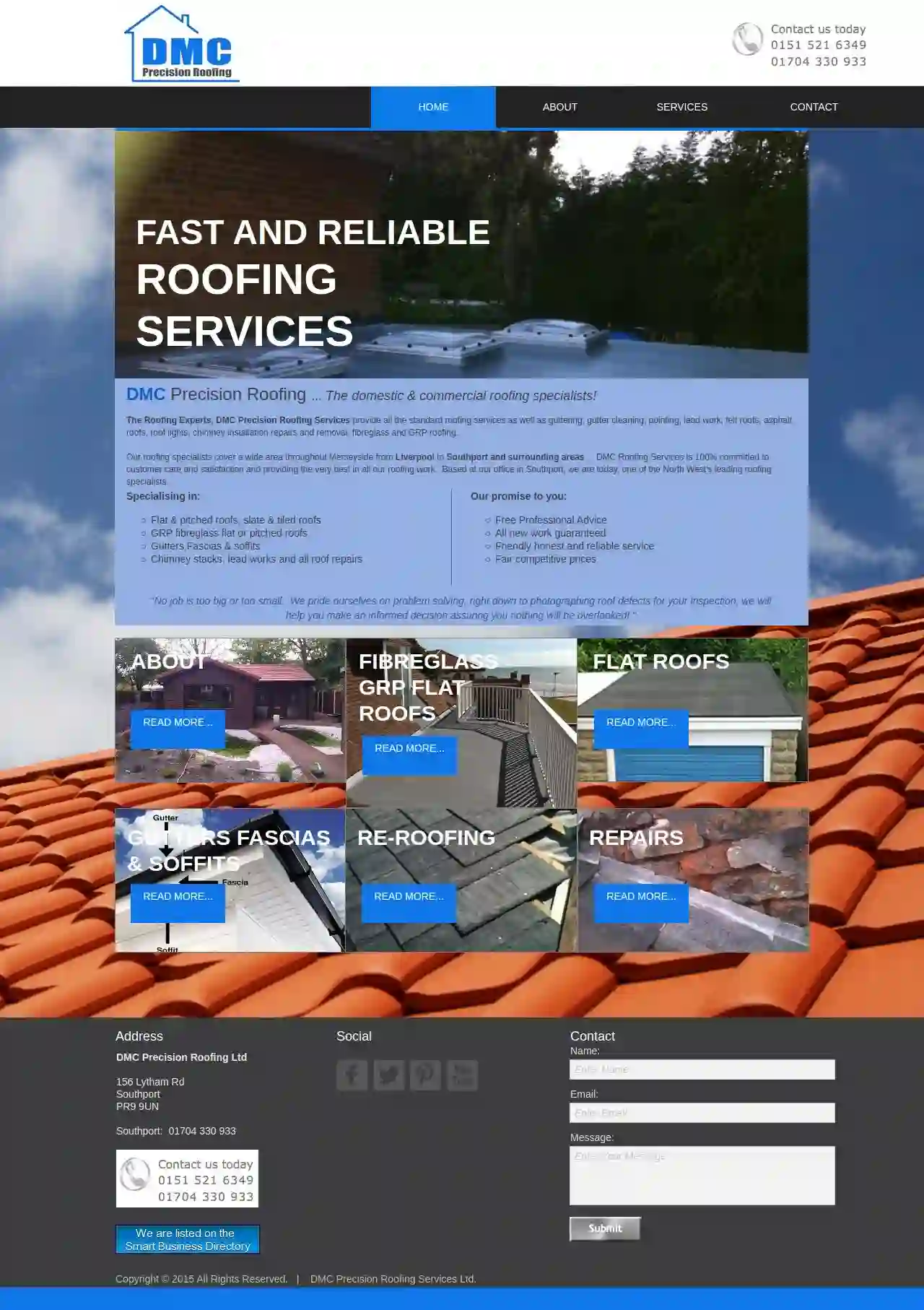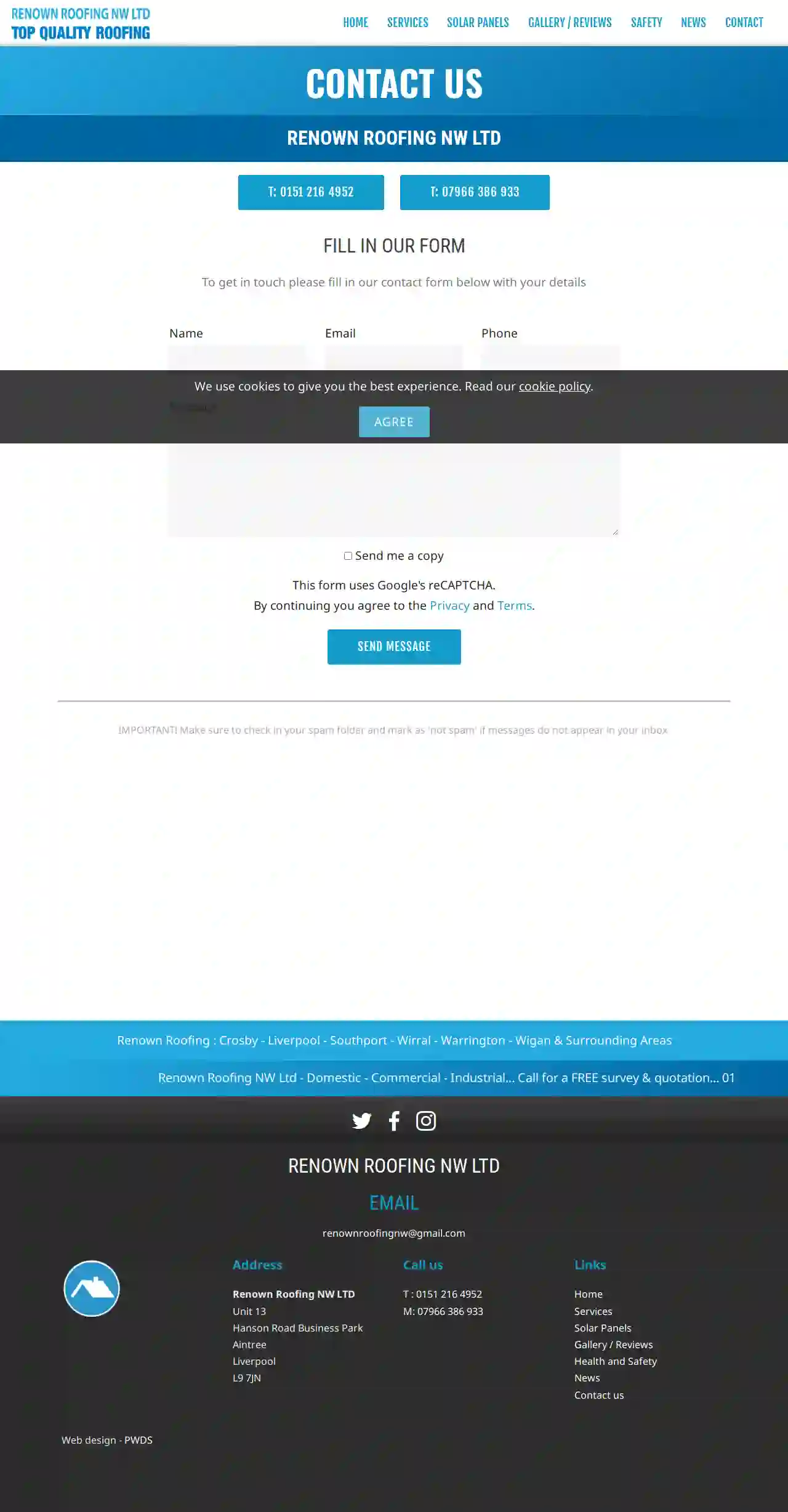Roofing Companies Kirkby
Find top Roofing Contractor in Kirkby
Get multiple Roofing Services quotes for your project today! Compare profiles, reviews, accreditations, portfolio, etc... and choose the best service.

Willow Roofing NE
59 reviewsArrow Close Business Centre, Killingworth, NE12 6QN, GBWillow Roofing NE is a roofing company run by David, who has over 23 years of experience as a roofer and 4 years of project management experience. We take pride in our well-established roofer and EPDM roofing specialist overseeing all work. We offer a range of services, including slating, tiling, full roof replacements, small repairs, roofline work, flat roofs, EPDM, leadwork, re-pointing, dry verge, dry ridge, solar panel removal and refitting, conservatory roof replacements, and Velux window fitting. We also offer cladding services. All our quotes are free of charge, and we'll discuss everything with you to give you peace of mind. We are professional from beginning to end. We cover the whole of the North East. Contact us using the form on the website for any queries.
- Services
- Why Us?
- Our Team
- Gallery
Get Quote
DMC Precision Roofing
57 reviews156 Lytham Rd, Southport, PR9 9UN, GBDMC Precision Roofing is a family-run business with over 25 years of experience in the roofing industry. We pride ourselves on providing exceptional quality service and are committed to customer care and satisfaction. Our team of time-served, qualified roofers has extensive experience in all aspects of domestic and commercial roofing. Based in Southport, we cover a wide area across the North West, including Formby and Liverpool. We offer a full range of roofing services, from standard roofing to more specialized services like GRP fibreglass flat or pitched roofs, gutters, fascias and soffits, chimney stacks, lead work, and roof repairs. We are available 24 hours a day for emergency call outs, ensuring your safety in unforeseen circumstances. We offer free professional advice and free quotes on demand. No job is too big or too small. We pride ourselves on problem-solving and will even photograph roof defects for your inspection to help you make an informed decision.
- Services
- Why Us?
- Gallery
Get Quote
James Roofing
36 reviewsBeacon Lee, Hillcroft Road, Liverpool, L25 6ER, GBAt James Roofing, we understand how important it is to take care of your property. We provide superior roofing services and are dedicated to ensuring that your property is respected at all times. Our experienced team of professionals have the tools, expertise, and commitment needed to get the job done quickly, safely, and efficiently. When it comes to roofing services, efficiency is key. We offer a value for money service with an eye for detail.
- Services
- Why Us?
- Testimonials
- Gallery
Get Quote
K.Schofield Roofing
54 reviewsLiverpool, GBAt K.Schofield Roofing we specialise in providing a high class standard of roofing workmanship for residential, commercial and industrial clients through-out Liverpool and Merseyside. We're dedicated to offering quality driven services at fair prices.
- Services
- Why Us?
- Gallery
Get Quote
Jones & Co Roofing
55 reviewsGBMerseyside Roofing Network is a network of trusted roofers serving both domestic and commercial clients across Merseyside. Our members are experts in all aspects of roofing, from repairs and maintenance to full installations. We understand that your roof is one of the most important parts of your home or business, and we are committed to providing high-quality workmanship at competitive prices. Whether you need a small repair or a complete roof replacement, our members can help. Contact us today for a free quote.
- Services
- Why Us?
- Gallery
Get Quote
North East Industrial Roofing Ltd
54 reviewsCrosby, GBWelcome to North East Industrial Roofing LTD, your trusted partner in roofing solutions. Established a decade ago by Craig Fowler, a seasoned professional with over 15 years of experience in the industry, we stand as a beacon of reliability and excellence in the roofing business.
- Services
- Why Us?
- Our Team
- Gallery
Get Quote
Renown Roofing NW LTD
51 reviewsAintree, Liverpool, Unit 13 Hanson Road Business Park, L9 7JN, GBRENOWN ROOFING NW LTD is a roofing company based in Crosby, serving Liverpool, Southport, Wirral, Warrington, Wigan and surrounding areas. We offer top quality roofing at sensible prices, built on a reputation for excellence. Our team is fully trained and certified, and we are covered by comprehensive insurance. We prioritize health and safety, ensuring a safe working environment for both our employees and the public. We are committed to providing excellent customer service and strive to exceed expectations on every project, big or small.
- Services
- Why Us?
- Testimonials
- Gallery
Get Quote
Chris Moody Roofing
4.979 reviewsUnit 1 West Park View, Dudley, Cramlington, NE23 7AA, GBChris Moody Roofing and Building is a 'Checked and vetted' & 'Trading standards approved' family run business based in Wideopen, Newcastle. Trading since 2011, with over 15 years’ experience in the roofing and building trade. We specialise in all types of roofing and external building works. We pride Ourselves on our commitment to provide a Professional, Personal and Speedy service from quote to completion, whilst maintaining the highest quality of work and using top quality materials.
- Services
- Why Us?
- Accreditations
- Our Team
- Testimonials
- Gallery
Get Quote
Level UP Lofts & Roofing ltd - Loft conversion specialists
56 reviewsUnit 8, George Business Park, Cemetery Road, Southport, PR8 5EG, GBLevel Up Lofts conversions provide our customers with a total "One Stop Shop" project management service from the development of your bespoke design until handover, which is always on time & always on budget. We can recommend one of our preferred Architects that we work with successfully on a regular basis.We will help you fit-out your space with any bespoke joinery requirements such as bedroom, office or gym furniture, just leaving you to complete the painting & decorating.Communication: We work well with our customers, communicating effectively at every stage on the programme progress and design development & improvement ideas.Installation: Our professional, motivated & friendly installation team will not leave your project until the construction is complete and you are 100% happy with all aspects of the conversion. All are staff are time served tradesmen for their respective individual trades. All electrical work undertaken comes with a full NIC certification. Guarantee: We are pleased to offer a 10-year Guarantee on all our works.Property Protection: All projects will involve scaffolding, skip hire and an outside workers toilet which will be installed ensuring your property's total protection. 90% of the construction materials essential for any loft conversion are mechanically lifted onto the scaffolding and enter the property through the roof. We will need entry to your property towards the end of the development when the stairs will need to be installed, taking every insurance to reduce disturbance to the occupants of the house. A full carpet protection system is laid to all necessary areas.Payment: We operate on a weekly payment structure running for the length of the development the first payment would be due after our first full week on site. This arrangement safeguards that we only ever request payments for any works that has previously been carried out.Experience: With over 20 years’ experience, our team of dedicated and professionally-qualified staff are totally focused on delivering your bespoke, beautiful, innovative & competitive designs.Questions: If you have any questions, please get in touch via our Contacts Page and you can also see our comprehensive FAQ page.One of the many benefits that Level Up Lofts deliver to our customers is that we part of the Roof Building Constructions company which have undertaken hundreds of roofing & building projects. Our experience in these elements ensure that we always deliver a successful project on time and on budget.
- Services
- Why Us?
- Gallery
Get Quote
Arnold Building & Joinery
52 reviewsWoodchurch Road, 100, Woodchurch, CH48 1AA, GBWirral Loft Conversions is a family-run business based in the Wirral, specialising in loft conversions, extensions and garage conversions. We pride ourselves on providing a professional, reliable and friendly service, with a commitment to quality workmanship and customer satisfaction. Our team of experienced builders and designers work closely with you to create your dream space, from initial consultation to completion. We offer a wide range of services to suit your needs and budget, including full loft conversions, dormer loft conversions, velux loft conversions, and more. We also offer a free no obligation quote. We understand that your home is your most valuable asset, and we treat every project with the utmost care and attention. We use only the highest quality materials and techniques to ensure that your loft conversion is both beautiful and durable. We are fully insured and registered with the Federation of Master Builders, giving you peace of mind that you are in safe hands. Contact us today to discuss your loft conversion needs. We look forward to helping you create the extra space you desire.
- Services
- Why Us?
- Accreditations
- Our Team
- Testimonials
Get Quote
Over 12,314+ Roofing Businesses in our network
Our roofing contractors operate in Kirkby and surrounding areas!
Roofyng.co.uk has curated and vetted the Best Roofing Contractors in Kirkby. Find a top & trustworthy contractor today.
Frequently Asked Questions About Roofing Companies
- Roof size and complexity
- Roofing material chosen
- Local labor costs
- Accessibility of the roof
- Removal of existing roofing
- Additional features (skylights, chimneys, etc.)
- Choose Reflective Roofing Materials: Opt for light-colored shingles or metal roofing that reflects sunlight and reduces heat absorption.
- Install Proper Attic Insulation: Adequate insulation prevents heat loss in the winter and heat gain in the summer.
- Ensure Adequate Ventilation: Proper attic ventilation allows hot air to escape, reducing cooling costs and extending the lifespan of your roof.
- Consider a Radiant Barrier: In hot climates, a radiant barrier installed in the attic can reflect heat away from the roof, further reducing cooling needs.
- Leaks or Water Stains: Water stains on ceilings or walls, dripping water, or dampness in the attic.
- Missing, Cracked, or Curled Shingles: Inspect for damaged or missing shingles, especially after a storm.
- Damaged Flashing: Look for rust, corrosion, or gaps in flashing around chimneys, vents, or skylights.
- Sagging or Uneven Rooflines: A sagging roof could indicate structural problems.
- Granule Loss: Excessive granules in gutters suggest aging asphalt shingles.
- Moss or Algae Growth: Can trap moisture and damage roofing materials.
How much does a new roof cost in the UK?
How can I make my new roof more energy-efficient?
What are some common signs of roof damage?
How often should I clean my gutters?
How much does a new roof cost in the UK?
- Roof size and complexity
- Roofing material chosen
- Local labor costs
- Accessibility of the roof
- Removal of existing roofing
- Additional features (skylights, chimneys, etc.)
How can I make my new roof more energy-efficient?
- Choose Reflective Roofing Materials: Opt for light-colored shingles or metal roofing that reflects sunlight and reduces heat absorption.
- Install Proper Attic Insulation: Adequate insulation prevents heat loss in the winter and heat gain in the summer.
- Ensure Adequate Ventilation: Proper attic ventilation allows hot air to escape, reducing cooling costs and extending the lifespan of your roof.
- Consider a Radiant Barrier: In hot climates, a radiant barrier installed in the attic can reflect heat away from the roof, further reducing cooling needs.
What are some common signs of roof damage?
- Leaks or Water Stains: Water stains on ceilings or walls, dripping water, or dampness in the attic.
- Missing, Cracked, or Curled Shingles: Inspect for damaged or missing shingles, especially after a storm.
- Damaged Flashing: Look for rust, corrosion, or gaps in flashing around chimneys, vents, or skylights.
- Sagging or Uneven Rooflines: A sagging roof could indicate structural problems.
- Granule Loss: Excessive granules in gutters suggest aging asphalt shingles.
- Moss or Algae Growth: Can trap moisture and damage roofing materials.